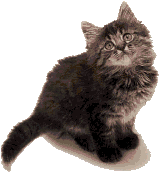|
|
|

Welcome to Tail Talk! We've learned in the previous tail lesson how cats use their tails. But what are they really
saying? That's what I'm going to try to explain here. Have fun!
![]()
The language of a cat's tail is beautiful! It's amazing how well they can communicate and let you know their moods.
Meowmie spends hours watching my tail, especially while she brushes me. She says that it is so relaxing. There
is so much grace and agility in a cat tail. It has purpose and dignity. Take a moment and watch how your cat communicates
with you through his/her tail.
![]()
A Waving Tail:
This means many things. It can mean that the animal is confused or undecided about something. This happens a lot
when you open the door for your kitty to go in or out of a room. It seems like they can't make up their minds whether
they want to go or stay. Unlike a dog's tail, a waving cat tail does NOT mean that the cat is friendly. In fact,
it usually means the opposite! You can get a nasty scratch by thinking this means a friendly cat.
![]()
Happy Tails:
These are neither stuck straight up in the air nor are they flopped down. The best way to describe them is as just
there. An easy and relaxed air about the tail indicates that kitty is also relaxed and feeling pretty much at ease
with the world around him/her. Another happy tail is the one that they usually greet their humans with when they
return home. The welcoming pet holds his/her tail directly vertical, straight up in the air from the rear end.
With his/her tail in this position, your cat will often display a quivering body motion, which indicates that he/she
is happy and actually excited "all over" that you are home. Isn't that sweet?
![]()
Aggressive Tail:
This is a VERY important signal to recognize. Many cat owners have avoided potentially dangerous situations by
being alerted to the aggressive tail signal. Angry tails have the same look about them as the fearful tail, reflecting
a fine line between fear and aggression. Cats, like most mammals including humans, very quickly turn fear into
fight, an instinctive tactic for self-preservation. Remember this and make sure to learn how to communicate with
your cat in a loving and non-threatening way. Cats will not tolerate attempts at intimidation, and fear may prompt
them to turn on the owner who tries to get obedience from their cat through dominance and bullying.
![]()
Swishing Tail:
Beware of the hard swishing tail! The faster the swishing and the harder the thumping, the more dangerous your
cat's mood is. Remember again that cats do not wag their tails with happiness the way dogs do. A mistake on your
part may mean scratches, bites, blood, tears, and hurt feelings for you!
![]()
Bristling Tails:
These are held in an upright, arched or curved position and indicate trouble! When a cat is truly frightened, the
tail won't be the only thing to bristle. The hairs on his/her back will stand up, as though she has been given
an electrical shock. This classic fright cat pose is seen very often in cartoons and comic books. It's funny when
you see it there but in real life, a scaredy-cat who displays this degree of fear should definitely be avoided.
A scaredy-cat is a dangerous cat!
![]()
Submissive Tails:
Submissive tails resemble aggressive tail. The thumping back and forth may mean that a cat has accepted your dominance.
Look carefully to see if he/she's holding his/her tail a little low to the ground, certainly lower than usual.
This may be your only clue that your cat is expressing submission instead of aggression. Some cats will commonly
adopt the most traditional and classic submissive pose: running from the scene with their tails tucked, literally,
between their legs. And at the extreme end of submission, the cat curls up in a frightened little ball and may
whimper or cringe. I did this for the first year or so that I lived here because I wasn't sure if I would be hit
or kicked. I don't do it any more though, because now I know that my family would never do that to me! This is
a very rare pose for independent cats and one that is usually the result of severe domination! If your cat has
been abused before you got him/her, it may take a lot of patience and work, and a lot of love, before you can start
working with her as you wish. (Note from Sassy's Meowmie: This is very true but it is such a wonderful reward when
they accept you! A warning however, that this will bring tears to your eyes when you see it. It makes you feel
so helpless! If you've had him/her since a kitten, and this pose is a result of your interaction, then maybe you
shouldn't have a cat!).
![]()
Inquisitive Tail:
This is great fun to watch! Curious kitties will often conduct their fascinating treasure hunts, prancing around
with their tails pointed straight up. Some cats add an enchanting little curlicue to the tip of their tails for
good measure. I do this often and it's meowmie's favorite time to watch me.
![]()
Balancing Tails:
Cats use their tails to help distribute their weight properly when they find themselves in precarious situations.
Though cats with no tails such as the Manx and cats who have had their tails removed somehow, learn to adjust and
can balance just as well!
![]()
Sick Tails:
A sick cat will often hold their tails in one of the submissive positions. Very often, the more submissive the
tail, the sicker the cat is. Be sure to check for this if your cat holds their tail in a submissive position often.
![]()